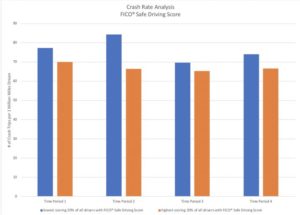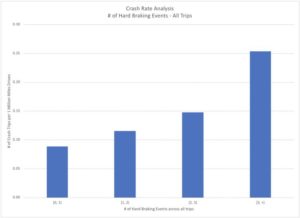Blog
How Data and Analytics Can Help Fleet Managers Keep Drivers Safe and Lower Costs
Originally published in Fleet Management Weekly 05/07/2019

By Rachel Bell, VP of Scores and Analytics, FICO
Despite advancements in safety technology, road fatalities are on the rise, with crashes involving large commercial vehicles going up by nine percent.
According to the National Highway Traffic Safety Administration, human error accounts for 94% of crashes. However, the latest generation of telematics are providing fleet managers with new insights into driver behavior that will have a significant impact on driver safety as well as operational costs in the future.
The latest telematics offer a wealth of new data sources that – when combined with predictive analytics – are helping to identify valuable insights that simply weren’t available before. By capturing the right data, fleet managers can help identify and reinforce safe driving behaviors across the fleet – ultimately leading to safer roads and lower costs for insurance carriers.
FICO® launched the FICO® Safe Driving Score, which uses telematics-based driving data provided by eDriving’s smartphone application, MentorSM. The FICO® Safe Driving Score can help predict the likelihood of future driving incidents by evaluating driver behaviors such as acceleration, braking, cornering, speeding and cellphone distraction, assigning and updating a driver’s risk score in real-time after each valid trip over time. The higher the score, the more likely a driver is to display safe driving behaviors and to avoid collisions in the future.
This focus on safe versus risky behaviors has the potential to yield life-saving results: by examining naturalistic driving data from a third-party research study, the 2nd Strategic Highway Research Program (SHRP2), which spanned three years, 3,000 drivers, and more than 30 million miles driven, we have been able to demonstrate that drivers identified by the FICO® Safe Driving Score as being higher risk for having future collisions are, indeed, more likely to incur a collision in the future than those identified as lower risk.
As this chart illustrates, the lowest scoring 20% of drivers were found to be up to 30% more likely to have a collision in the future than the highest scoring 20% of drivers.
Furthermore, our analysis has concretely verified the assumption that unsafe driving behaviors, such as hard braking events, are correlated with higher risk of future collisions.
As the above chart demonstrates, trips with three or more hard braking events are more than 2.5 times more likely to result in a collision than those with no such events.
Predicting future collisions based on telematics-based driving data alone is challenging – the data can be noisy even within a somewhat “controlled” environment; the behaviors can vary based on extraneous events such as weather, traffic flow, or even mood of the driver; and connecting the telematics-based driving data to the outcome (collisions, losses, etc.) can be expensive and takes time.
The benefits of safer roads and lower costs for fleets greatly outweigh the challenges. As technology continues to improve and resources like the FICO® Safe Driving Score become more accessible, companies will have a clearer line of sight to enable safer driving behavior moving forward, which will ultimately help their employees return home safe to their families every night.

